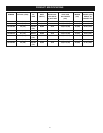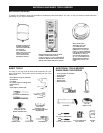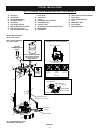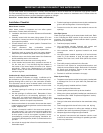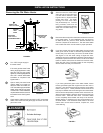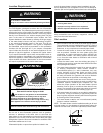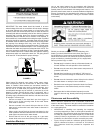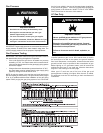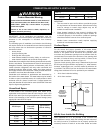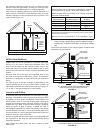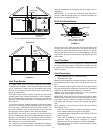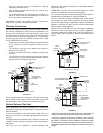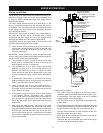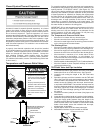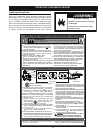
16
Gas Pressure
WARNING
Explosion Hazard
• Gas leaks can not always be detected by smell.
• Gas suppliers recommend that you use a gas
detector approved by UL or CSA.
• For more information, contact your gas supplier.
• If a gas leak is detected, follow the “What to do if you
smell gas” instructions on the cover of this manual.
IMPORTANT: The gas supply pressure must not exceed the maximum
supply pressure as stated on the water heater’s rating plate. The
minimum supply pressure is for the purpose of input adjustment.
Gas Pressure Testing
IMPORTANT: This water heater and its gas connection must be
leak tested before placing the appliance in operation.
• If the code requires the gas lines to be tested at a pressure
exceeding 14” W.C., the water heater and its manual shut-off
valve must be disconnected from the gas supply piping system
and the line capped.
• If the gas lines are to be tested at a pressure less than 14” W.C.,
the water heater must be isolated from the gas supply piping
system by closing its manual shut-off valve.
NOTE: Air may be present in the gas lines and could prevent the
pilot from lighting on initial start-up. The gas lines should be purged
of air by a qualified technician after installation of the gas piping
system. While purging the gas piping system of air, ensure that
the fuel is not spilled in the area of the water heater installation,
or any source of ignition. If the fuel is spilled while purging the
piping system of air follow the “WHAT TO DO IF YOU SMELL
GAS” instructions on the cover of this manual.
LP Gas Only
WARNING
Explosion Hazard
Have a qualified person make sure L.P. gas pressure
does not exceed 13” water column.
Examples of a qualified person include: licensed
plumbers, authorized gas company personnel, and
authorized service personnel.
Failure to do so can result in death, explosion, or
fire.
Liquefied petroleum gas is over 50% heavier than air and in
the occurrence of a leak in the system, the gas will settle at
floor level. Basements, crawl spaces, closets and areas below
ground level will serve as pockets for the accumulation of gas.
Before lighting an L.P. gas water heater, smell all around the
appliance at floor level. If you smell gas, follow the instructions
as given in the warning on the front page.
When your L.P. tank runs out of fuel, turn off the gas at all
gas appliances including pilot lights. After the tank is refi lled,
all appliances must be re-lit according to their manufacturer’s
instructions.



